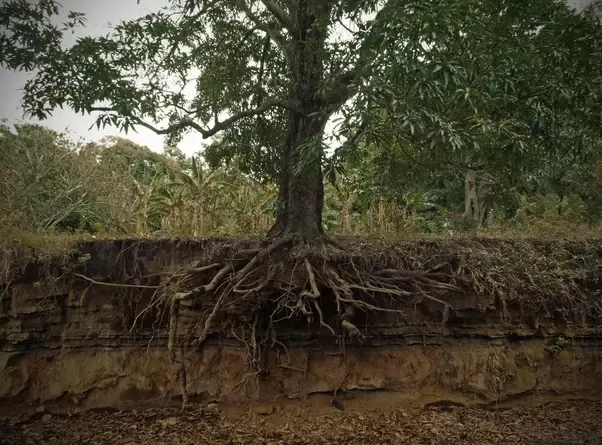The delicate dance of nature and architecture often raises questions as intriguing as life itself. Today, we shine a spotlight on the mighty mango tree, its tantalizing fruits adored by many. But beyond its deliciousness, lies a haze of mystery: can these towering beauties, with roots that delve into the earth with fervor, pose a threat to the steadfast foundations of our humble abodes? It is time to unravel the enigma of the mango tree and its potential impact on our homes, exploring the realms where foliage meets foundation. Step into a world where nature’s embrace and human habitation intermingle, and let us delve into the depths of this captivating puzzle with a neutral eye.
Overview of Mango Tree Roots and Their Growth Patterns
When planting a mango tree in your backyard, it’s essential to understand the growth patterns and potential impact of its roots, especially on nearby structures like your foundation. Mango tree roots, like those of most trees, possess the ability to generate significant force as they grow. However, it’s essential to dispel the notion that mango tree roots are notorious for damaging foundations.
1. Growth Pattern:
- Mango tree roots tend to grow horizontally rather than vertically, primarily in search of water and nutrients.
- They can spread up to three times wider than the tree’s canopy, but the majority of the roots remain concentrated within the top two to three feet of soil.
- The root system is relatively shallow, extending just beneath the surface, making it less likely to disrupt deep foundations.
2. Foundation Impact:
- While mango tree roots do exert some force on the ground, it’s usually not enough to damage or crack a solid foundation.
- However, caution should be taken if the tree is planted too close to the foundation, as a combination of expansive soil and aggressive root growth could potentially pose a risk.
- Regular maintenance, such as periodic inspections and pruning, can help mitigate any potential foundation concerns associated with mango tree roots.
| Features | Tips | |
|---|---|---|
| 1. Horizontal root growth | 1. Plant mango tree at a safe distance from the foundation. | |
| 2. Shallow root system | 2. Regularly inspect and prune the roots to maintain a safe distance from the foundation. | |
| 3. Limited vertical growth | 3. Consider installing a root barrier if the tree is planted too close to the foundation. |

Potential Risks Posed by Mango Tree Roots to Foundation
Mango trees may be a beautiful addition to your garden, but did you know that their roots have the potential to cause damage to the foundation of your home? The expansive root system of mango trees can spread far and wide, seeking out water and nutrients. While this is beneficial for the tree, it can be detrimental to nearby structures, such as foundations.
One of the main risks posed by mango tree roots is their ability to penetrate through cracks and weaknesses in a foundation. As the roots grow and expand, they can exert pressure on the foundation, causing it to shift or crack. This can lead to structural problems, such as uneven floors, sagging walls, or even foundation failure. Additionally, the roots may absorb moisture from the soil surrounding the foundation, leading to soil shrinkage and further destabilizing the structure. It is important to be mindful of this potential risk and take necessary precautions to protect your foundation.
| Features | Tips |
|---|---|
| Regular inspection of foundation | Ensure any cracks or weaknesses are promptly repaired |
| Proper tree placement | Plant mango trees at least 20 feet away from your home |
| Barrier installation | Consider installing a root barrier to prevent root intrusion near the foundation |
By being aware of the potential risks and taking preventive measures, you can enjoy the beauty of mango trees in your garden without worrying about damage to your foundation. It is always prudent to consult with professionals if you have concerns about the placement of trees or the integrity of your foundation. With proper care and attention, you can mitigate the risks posed by mango tree roots and ensure the stability of your home for years to come.
Factors Mitigating the Risk of Mango Tree Root Damage: Location and Maintenance
One of the key concerns for homeowners when planting mango trees is the potential damage to their foundation caused by the tree’s roots. However, there are several factors that can mitigate this risk and ensure a harmonious coexistence between mango trees and your home. Two critical factors to consider are the location of the tree and proper maintenance.
Choosing the right location for planting a mango tree is crucial in preventing root damage to your home’s foundation. Mango trees should ideally be planted at least 10-15 feet away from any structures. This distance allows the roots to spread out without interfering with the foundation. Additionally, it is important to avoid planting mango trees too close to sewer lines or large underground utilities, as their roots can cause blockages or damage to these systems. Regular maintenance practices like pruning the tree’s roots can also help control their growth and avoid any potential foundation issues. Removing damaged or diseased roots is essential, as it promotes healthy growth and minimizes the risk of root-related damage.
To ensure the proper care and growth of your mango tree while safeguarding your foundation, consider the following features and tips:
| Features | Tips |
|---|---|
| 1. Well-draining soil | 1. Choose a planting location with soil that drains well to prevent water buildup. |
| 2. Adequate sunlight | 2. Select a spot where the mango tree receives at least 6-8 hours of direct sunlight daily. |
| 3. Mulching | 3. Apply a layer of organic mulch around the tree to conserve moisture and reduce weed growth. |
By considering the location of your mango tree and maintaining it properly, you can enjoy the delicious fruit it produces while protecting your home’s foundation from any potential damage. Remember, with proper planning and care, these beautiful fruit trees can be a delightful addition to your garden without causing any harm.
Practical Measures to Safeguard Foundations from Mango Tree Root Hazards
Foundations are the bedrock of any structure, providing stability and strength. However, in certain areas where mango trees thrive, their extensive root systems can pose potential hazards to foundations. These robust roots seek moisture and can infiltrate foundations, causing damage over time. To protect your valuable property, it is essential to implement practical measures that can safeguard your foundations from the potential risks posed by mango tree roots.
Here are some valuable features and tips that can help you prevent and mitigate the potential damage caused by mango tree roots:
| Feature/Tip | Description |
|---|---|
| Root Barrier Installation: | Consider installing a root barrier underground around your foundation which prevents the lateral growth of mango tree roots towards your structure. |
| Regular Tree Maintenance: | Ensure proper pruning and maintenance of mango trees regularly to prevent excessive root growth and reduce potential risks to foundations. |
| Foundation Waterproofing: | Apply quality waterproofing products to your foundation walls and floors, creating a protective barrier against moisture intrusion from mango tree roots. |
By implementing these practical measures and staying proactive, you can protect your foundations from potential damage caused by the relentless pursuit of moisture by mango tree roots. Don’t underestimate these natural hazards – take the necessary steps to ensure the longevity and safety of your property. Remember, prevention is always better than repair!
Frequently Asked Questions
Q: Can mango tree roots pose a threat to the foundation of a building?
A: Let’s dig into the ground-breaking truth about mango trees and their potential impact on building foundations!
Q: Are mango tree roots strong enough to cause damage to a foundation?
A: Brace yourselves, for the mighty roots of mango trees can break through concrete walls and conquer foundations with their sheer strength!
Q: Can preventive measures be taken to protect a foundation from mango tree roots?
A: Fear not, for we reveal the secret techniques to fortify your foundation against the formidable force of mango tree roots. Prepare to witness the battle between structure and nature! As we conclude our exploration into the mystical world of mango tree roots and their potential impact on foundations, we’re left with a sense of awe at the intricate dance of nature. From the majestic mango tree that stands tall, bearing succulent fruit, deep into the earth below, the roots embark on an extraordinary journey.
While we have delved into countless stories of folklore and mythical tales of mango trees wreaking havoc on unsuspecting foundations, let us now bring our focus back to reality. In the realm of facts, we find an equilibrium between caution and rationality.
Rest assured, dear readers, for mango tree roots pose no immediate threat to strong, well-constructed foundations. These resilient roots possess a remarkable talent for adapting and seeking paths that avoid confrontation with any solid structure that may stand in their way. They understand the subtle art of coexistence, their innate wisdom guiding them to nourish themselves without causing harm.
However, in the realm of possibilities, we must acknowledge that all things in life are subject to change. The unyielding forces of nature, though seemingly gentle in their intent, can sometimes conceal surprises. It is not inconceivable that under certain circumstances – extreme weather conditions, soil erosion, or weakened barriers – mango tree roots may extend their exploratory reach beyond the expected boundaries.
Yet, even if the hypothetical becomes a reality, we need not fear. With a watchful eye and an attentive hand, any potential threat can be mitigated. Responsible homeowners and diligent gardeners possess the tools to address these challenges, ensuring the harmonious coexistence of mango trees and foundations.
So, as we bid farewell to our journey through the mystical realm of mango tree roots, let us approach reality with newfound appreciation. Let us embrace the beauty of mango trees, the joy they bring with their bountiful harvest, and the serenity they offer under their welcoming shade, secure in the knowledge that their roots and our foundations can coexist in harmony.
- When to Put Weed and Feed on Lawn in Michigan - October 16, 2023
- When to Fertilize Potatoes Plants - October 16, 2023
- Can You Plant Clover in the Spring - October 16, 2023
Contents

